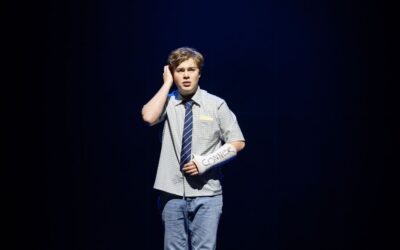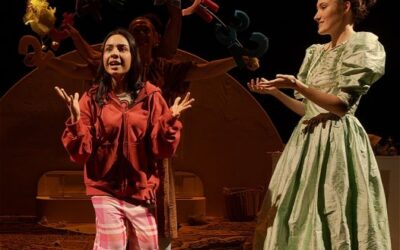The Great Gatsby is a novel written by American author F. Scott Fitzgerald in 1925. It tells the story of Nick Carraway’s interactions with his millionaire neighbour, the mysterious Jay Gatsby, and Gatsby’s desperation to reunite with his former lover, Daisy Buchanan. The novel was inspired by a romantic fling the author had with a Long Island socialite in the early 1920s. The novel has received great critical acclaim and is considered to be one of America’s greatest novels. Since publication, the story has been adapted numerous times for film, stage and even immersive experiences. This stage adaptation is by American Simon Levy.
The challenge of a stage adaption is the limitation on being able to convey the same level of detail contained in the novel, and no doubt those familiar with the novel will pick up the many symbolic references to the original story throughout the play. However, for those new to The Great Gatsby, those references will go unnoticed. The story plays out on stage largely as a set of complicated love triangles and while there are references to the lavish parties of the wealthy and the hedonistic jazz era, their significance is somewhat lost without the literary details. This is not the fault of this production, but the challenge of adapting a literary work to the stage.
The production is set on a largely bare stage. A large billboard looms toward the back of the stage – a symbolic reference of the billboard depicted in the novel that gives an ominous presence of the actions of the locals always being watched. However, there is no reference to this in the actual script and if you had not read the book, this is a somewhat confusing backdrop. The “billboard” then becomes the set backdrop, with various images being projected onto the screen to establish the location of each scene. A large black star curtain lights up the very back of the stage, and while it works to add a sense of atmosphere to the party scenes at Gatsby’s mansion, the bright star lights are a little distracting from other scenes. Set design (Gordon Hunneybell) allows for very smooth and efficient scene changes, with period furniture pieces being brought on and off stage to help create a sense of the opulence of the socialite lifestyle. However, the minimalist set doesn’t quite convey the opulent lifestyles of these wealthy socialites and the challenges of the American class system may not be as apparent as depicted in Fitzgerald’s novel.
Luke Peverelle is excellent as Nick Carraway, effectively the narrator of this story. His grounded and reflective portrayal serves as a contrast to the lavish lifestyles of those around him.
Rob Blowers delivers a charming portrayal of millionaire Jay Gatsby. There are fleeting references that question how Gatsby made his money, but the play doesn’t quite create the sense of mystery surrounding the “Great” Jay Gatsby.
Daisy Buchanan is thoroughly convincing as Daisy Buchanan. Julian Campobasso brings a strong and imposing presence to the stage as Tom Buchanan.
Melody Taylor is delightful as Jordan Baker.
Nathan Williams delivers a heartfelt performance as George Wilson, while Georgia Claire gives a good performance as his wife Myrtle.
Rounding out the cast in ensemble roles are Jackson Langelaan and Ellen Leask.
Lighting design by Robin Le Blond works well to create a sense of time and mood, as well as some nods to the symbolism in the book. Wardrobe by Jayne Ruddick and Brigitte Thompson establishes the 1920s era. Choreography by Melody Taylor also leaves any doubt of the era, with some nice Charleston moves being managed by the cast.
Despite sitting just four rows from the front, some lines were difficult to hear at times, particularly when the character was pensive, or lines were being delivered toward the back of the stage. While the cast did a splendid job maintaining their accents, some lines during heated moments, whilst passionately delivered, were at times very difficult to understand.
Director Erin O’Hare has delivered a good production of The Great Gatsby and it’s exciting to see her progression and development as a director since her first involvement in the Centrestage Youth Theatre more than a decade ago. Indeed the 1812 Theatre Company has a bright future as the youth theatre community develop and move into the mainstage productions.
While the script doesn’t delve into the depths of the novel, this stage adaptation of The Great Gatsby serves as a good introduction to the story and the play just might inspire audience members to pick up this classic work of American literature and explore all the deeper messages and moments of symbolism they may have missed – and understand the relevance of those imposing eyes at the back of the stage.
The Great Gatsby is now playing at the 1812 Theatre in Upper Ferntree Gully.
https://www.1812theatre.com.au/





